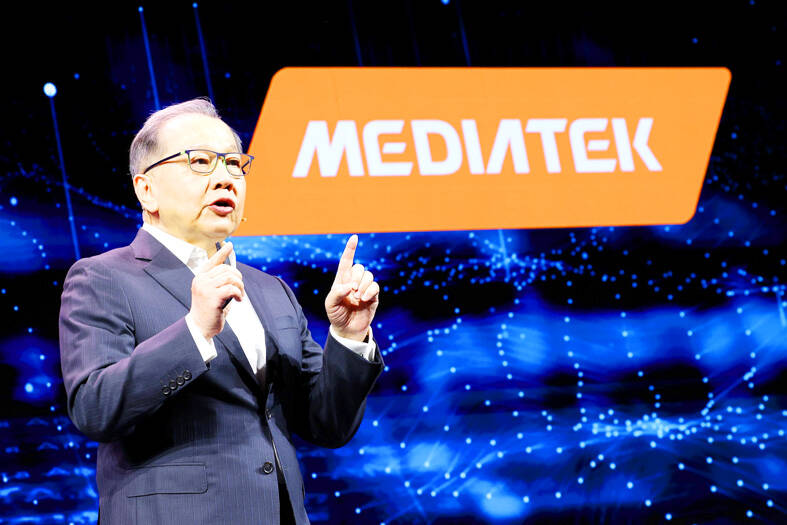Chip designer MediaTek Inc (聯發科) yesterday said revenue this quarter would contract by 4 percent sequentially in the worst-case scenario on softer smartphone demand.
Revenue is expected to be between NT$147.2 billion and NT$159.4 billion (US$4.6 billion-US$4.98 billion), compared with NT$153.31 billion last quarter, the company said.
MediaTek said demand for smartphone chips would be flat or slide sequentially this quarter, while demand for smart devices and power chips would go up. Mobile phone chips made up 56 percent of the company’s total revenue last quarter.

Photo: RITCHIE B. TONGO, EPA-EFE
Gross margin of 46 to 49 percent is forecast for this quarter, compared with 48.1 percent last quarter, the company said.
“Despite the market uncertainties, there are no material order changes from customers, partly due to the long production cycle time,” MediaTek chief executive officer Rick Tsai (蔡力行) said at an online earnings conference.
MediaTek did not provide full-year growth projections, citing the potential impact from US tariff and trade policies.
“We are certainly watching very closely the potential impact on other markets, such as China, Japan, [South] Korea, etc. That’s why we said, as many other CEOs have also, that we remain quite cautious about the second half of the year. The risks for us ... [are that] we rely more on consumer electronics, such as TVs or some of the home devices,” Tsai said.
Still, the company is not overly pessimistic, he said, adding that tariffs would have limited impact on its business due to its low exposure to the US market, which accounted for 10 percent of its total revenue.
For the mid to long-term, the trend toward ubiquitous artificial intelligence (AI) remains intact and its growth prospects remain solid, the company said.
MediaTek yesterday kept unchanged its goal of generating more than US$1 billion in revenue from supplying AI application-specific integrated circuit (ASIC) chips next year.
The company unveiled its cooperation with Nvidia Corp over the AI ASIC development at the US firm’s annual GTC conference earlier this year.
“Yes, we did have a good discussion and engagement with our partner, Nvidia. The work is in its early stage... I would prefer to defer further discussion to another time,” Tsai said.
For enterprise ASIC, MediaTek has high confidence about its capabilities to design customized AI accelerators based on its key technologies and intellectual properties, Tsai said.
The company said it has secured several “design-ins” and “design-wins” for the new ASIC business.
During the first quarter of this year, MediaTek saw net profit decline 7 percent to NT$29.33 billion from NT$31.54 billion a year earlier. On a quarterly basis, net profit surged 23.3 percent from NT$23.79 billion.
Earnings per share dropped to NT$18.43 from NT$19.85 a year ago, but rose from NT$14.95 a quarter earlier.
Gross margin fell to 48.1 percent, compared with 52.4 percent one year earlier and 48.5 percent the prior quarter.

RUN IT BACK: A succesful first project working with hyperscalers to design chips encouraged MediaTek to start a second project, aiming to hit stride in 2028 MediaTek Inc (聯發科), the world’s biggest smartphone chip supplier, yesterday said it is engaging a second hyperscaler to help design artificial intelligence (AI) accelerators used in data centers following a similar project expected to generate revenue streams soon. The first AI accelerator project is to bring in US$1 billion revenue next year and several billion US dollars more in 2027, MediaTek chief executive officer Rick Tsai (蔡力行) told a virtual investor conference yesterday. The second AI accelerator project is expected to contribute to revenue beginning in 2028, Tsai said. MediaTek yesterday raised its revenue forecast for the global AI accelerator used

TEMPORARY TRUCE: China has made concessions to ease rare earth trade controls, among others, while Washington holds fire on a 100% tariff on all Chinese goods China is effectively suspending implementation of additional export controls on rare earth metals and terminating investigations targeting US companies in the semiconductor supply chain, the White House announced. The White House on Saturday issued a fact sheet outlining some details of the trade pact agreed to earlier in the week by US President Donald Trump and Chinese President Xi Jinping (習近平) that aimed to ease tensions between the world’s two largest economies. Under the deal, China is to issue general licenses valid for exports of rare earths, gallium, germanium, antimony and graphite “for the benefit of US end users and their suppliers

Dutch chipmaker Nexperia BV’s China unit yesterday said that it had established sufficient inventories of finished goods and works-in-progress, and that its supply chain remained secure and stable after its parent halted wafer supplies. The Dutch company suspended supplies of wafers to its Chinese assembly plant a week ago, calling it “a direct consequence of the local management’s recent failure to comply with the agreed contractual payment terms,” Reuters reported on Friday last week. Its China unit called Nexperia’s suspension “unilateral” and “extremely irresponsible,” adding that the Dutch parent’s claim about contractual payment was “misleading and highly deceptive,” according to a statement

Artificial intelligence (AI) giant Nvidia Corp’s most advanced chips would be reserved for US companies and kept out of China and other countries, US President Donald Trump said. During an interview that aired on Sunday on CBS’ 60 Minutes program and in comments to reporters aboard Air Force One, Trump said only US customers should have access to the top-end Blackwell chips offered by Nvidia, the world’s most valuable company by market capitalization. “The most advanced, we will not let anybody have them other than the United States,” he told CBS, echoing remarks made earlier to reporters as he returned to Washington